There’s no question that since their arrival the goats have become the focal point of the farm. A lot has changed here over the last couple of years, and our life now is very much planned around the goat year.
As our small herd slowly expands we find ourselves reorganizing things on the farm, which usually means adding to our list of construction projects.
Admittedly, sometimes projects take a little longer than planned as our attention does get diverted through the year.
First of course, there was the barn we built before the girls arrived. Then the bucks were added to the farm this spring, so we relocated the turkeys, and constructed a secure buck pen, and shelter for Zedoary, and Darby.
Although the barn we built, along with the predator proof outdoor run, is working great, and the area gets copious amounts of sunshine in the spring and summer months, winter can be a bit gloomy. Due to the sloping terrain here, drainage, thankfully, hasn’t been a problem. However, as the days get shorter, and the sun slowly sinks in the sky during the fall and winter months, the shadows from the surrounding woodland stretch ever longer, until by the winter solstice direct sun in the girl’s yard is almost a distant memory.
We’ve occasionally used our portable electric fence, which we can move around as needed. This spring we set it up so the kids had a sunny area to play away from the older does, but unless the fence is charged (which isn’t always easy to do depending on where we put it), the goats invariably step through it, get their heads stuck in it, and generally get up to mischief.
Even as a temporary solution, this fence has been less than ideal, and if we leave it standing when the goats aren’t using it, the deer subsequently manage to tangle themselves in it too. Quite honestly, this fence is generally more trouble than it’s worth.
However, there’s an area up slope of the barn that faces south west, that gets a tremendous amount of sunshine, even in the darkest winter months. This is a disused area, that we initially considered incorporating into the orchard area. However, after pulling hundreds of feet of deer fence across the slope, we decided to leave it unfenced.
I then planned to turn this area into a native grass and flower meadow. Unfortunately, the voles, gophers, and deer all had a different plan after the first seeds were sown. So, admitting defeat I elected to plant daffodils there instead, as this area is visible as you approach the house, and neither gophers, nor deer, are willing to eat them.
Then last year we decided it really was wasted space for most of the year, and the only thing we’d been successful at farming in that location was gophers. We decided it would be much better utilized by the goats as an area for them to run, bounce, play, and browse, especially on those warmer, and sunny, winter’s days.
I started by first removing the daffodils, and replanting them elsewhere, as they’re not any more palatable to goats, than they are to the deer. Then I had to source the fencing material. As farms dwindle in this area, it becomes increasingly difficult to find certain types of materials, including no climb fence!
We then had to decide how best to fence this area. For the record, we will never go out of our way to purchase a property again with this much grade change. It’s beautiful here, quiet, secluded, but the terrain is exhausting. We elected to use 4×4 posts, as they’re sturdier than T-posts, especially in our loose soils, to support the no climb fencing. Properly installed, this fencing is strong, and flexible, especially important considering our uneven terrain.
As this new goat pasture area is immediately adjacent to the orchard and garden it was especially important to build a secure enclosure, as a number of trees in the orchard are known to be toxic to goats, and let’s face it, our orchard has been tormented enough by the resident deer population over the years.
When we were planning out where to put the fence, we were most concerned about the fence height at the foot of the slope. Much the same as when we built the deer fence, we knew the goats would have an advantage coming down toward the driveway from up slope. As such, we knew the fence height would need to be taller at the foot of the slope, but we didn’t want to make the fence too tall, from an aesthetic perspective, at the top of the hill. We solved this by installing 4 foot no climb around the perimeter, except along the front edge at the toe of the slope, where the fencing is 5 feet tall to accommodate the change in grade.
The rains virtually disappeared by January, so in February, while the soils were still damp, we started to set the first posts. We have a lot of mud stone in this area, and we knew from installing the orchard, and the garden retaining wall, that digging in these soils is almost impossible once they dry out for the season.
We started this fence back in February. It’s now the end of September.
In March, Lotus kidded, and my focus was on raising kids, training a first freshener to be milked, and planning our upcoming show season.
The kids, of course, sent productivity, especially in regards to fencing projects, screeching to an absolute halt. Really, I’d much rather be taking care of them, than digging post holes!
Then we had to build a new enclosure for the turkeys, and the buck pen of course.
Before we knew it, the first show of the season was upon us, which of course leads to more time spent bathing, and grooming goats, packing up show gear, travel, unpacking show gear, and then rinsing and repeating as required through the remainder of season.
Show season was a lot of fun this year, and very successful, but now that the season is finally over, and breeding season looming, it really was time to wrap up our fencing project, because kidding season will be upon us again before we know it, and we expect next spring to be even busier!
Of course, by now, with the drought in full swing, the soils were rock hard, which slowed progress down somewhat. Over the course of a couple of weekends though, we made great progress.
That is right until, one afternoon, while helping to stretch a section of this no climb fence, I stepped, squarely, and regrettably, into a yellow jacket nest.
We’ve had some formidable wasp nests on the farm before, but this nest was unbelievable. I’ve never been stung so much in my life, and yellow jackets can be especially aggressive, and pursue a fleeing farmer for a much greater distance than European honey bees ever will. All the way into the house to be exact!
I was stung on the scalp, face, arms, and my back, before I could get away. A few even clung to my shirt as I ran in to the house. After agitating that nest, we couldn’t get within 10 feet of the fence line without setting them off again. Yet again, fence construction stopped. We still had posts to set along that section of fence line, and fencing to stretch and secure in place.
We considered taking the nest out, but due to a thicket of poison oak that cropped up there since last spring, we were only to able to gauge approximately where the nest was located, and never have found the entrance, so the nest is still there. Once winter sets in, and the yellow jackets are no longer a threat, we’ll clear out this area, but for now we’ve just had to be more creative, and careful, about working around them.
We’ll also be setting out our traps for yellow jacket queens earlier next year, before another nest of this magnitude gets re-established. Equipped with bee suits, we set back to work, determined to get this pasture area finished.
So between loose soils, the grade of the terrain, and formidable yellow jacket nests, this is the fence that almost wasn’t, and we’re starting to loathe installing fencing on slopes, even though we are getting quite good at it.

The slope, angle, and curve, made it challenging to stretch the fence. Here we used the tractor to help maintain tension while the fence was secured
Finally, this weekend, we had the fence secured enough so the girls could test it out. There is a saying that “if a fence won’t hold water, it won’t hold a goat“. Well, that’s a slight over-exaggeration, but not by much! We felt this fence is sturdy though, so it was finally time to put it to the test.
Lia was happy to be the first to volunteer to test both the height of the fence down slope, to make sure we had made it tall enough, as well as the strength of the no climb fencing we installed. Here Lia is demonstrating why not to use spot-welded fencing in goat pastures. Goats LOVE to stand on fences, and spot welds simply aren’t strong enough to take that sort of abuse over time.
Of course, calling this a ‘pasture’ fence, in the middle of a drought, is a little ambitious, as at the moment it looks more like a dry lot, but things will green up a little once the rains return. Besides, goats would much rather eat blackberry vines, than grass, just ask Minnie.
There is still some native blackberry on the slope though, and lots of crunchy leaves for snacking on.
The girls had a lot of fun exploring yesterday, although Minnie was convinced that the browse is better on the other side of the fence. At the moment, I have to agree.
The slope gives the girls quite a view across parts of the property, perfect for keeping watch on the farmers, or passing deer, or wandering turkeys.
As herd queen Minnie is always hyper aware of her surroundings, and the first to greet anyone at the gate. She does like to stand ON the gate though, making it more difficult to open.
Lily just pushes her nose through the fence to say hello.
While we could still get the tractor to this area we installed a few large rocks for the girls to stand on, and Lily had a blast yesterday launching herself off them as she chased the other girls around.
For some reason, the rocks looked much so larger in the truck, and while we were rolling them into place, than they do now they’re in the pasture. Oh well, I expect we’ll add a few more by next spring.
This is the first time Lily has spent much time out loose with the does all together, so she and Minnie had a few things to discuss at first. Minnie can be a bit of a bully, so these two are still only allowed out together under strict supervision.
There’s still some cleanup to do outside the fence, and some planting too. The soils are quite loose on this slope. Now that fall planting season is upon us, we’ll plant some ground cover shrubs for erosion control along the toe of the slope, and once the rain returns in earnest, we’ll sow some pasture mix inside the fenced area to help hold the soils in place over winter.
There are a few minor things to finish, mostly in the corner of the fence closest to the yellow jacket nest, including replacing a temporary post brace with a permanent one, but we’re almost done. We’ll also be changing out the old white arbor at the top of the hill over winter, replacing it with one that ties in better with this new fencing, as our new permanent entrance to the orchard. No more fence post holes are getting dug though until the ground softens from the fall rains!
In the meantime though, as it’s now breeding season, over the coming weeks the boys will be spending some time in this enclosure too, as they’re each introduced to their prospective dates this season.
By next spring, once the weather warms, I’m looking forward to watching next season’s kids bouncing around in this new pasture, which should look a little more green by then, but first I’m crossing my fingers for some early fall rains, as I have a lot of planting to get done!


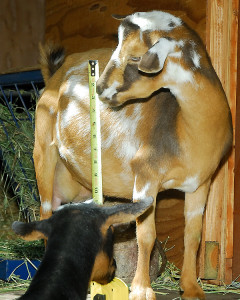
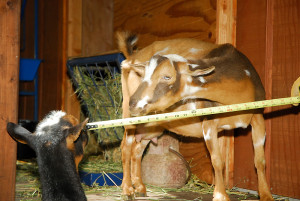
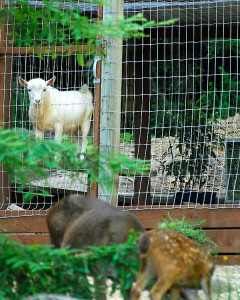
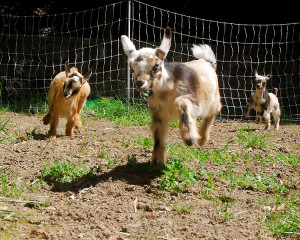
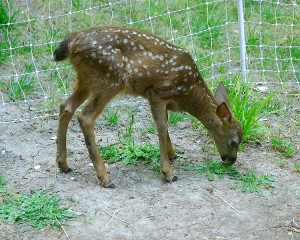
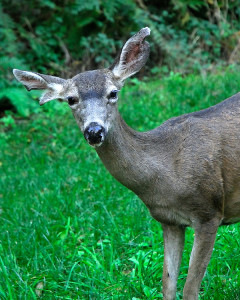
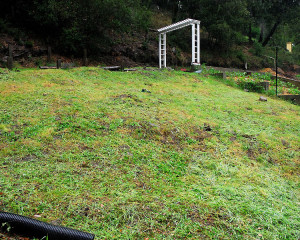
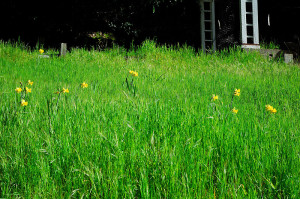
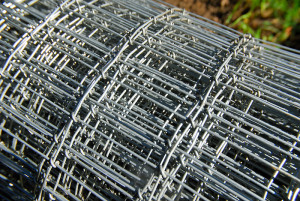
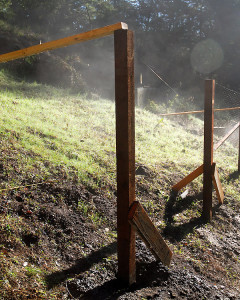



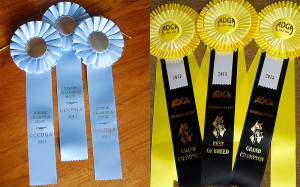



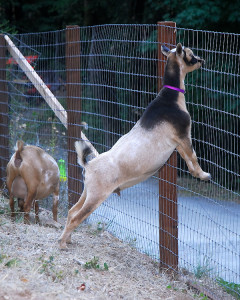

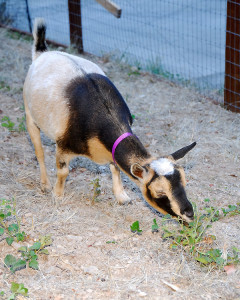
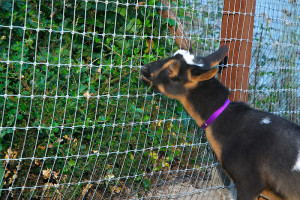
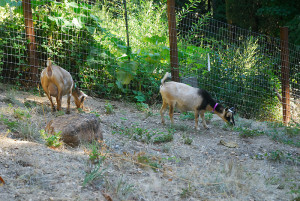
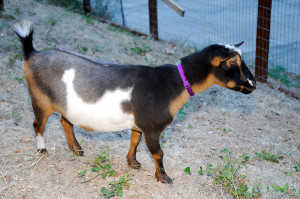
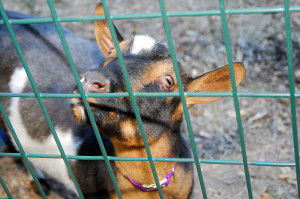

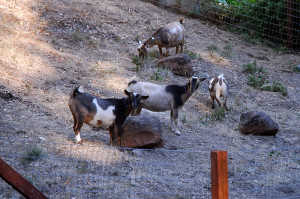
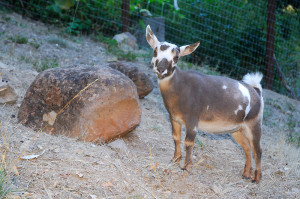
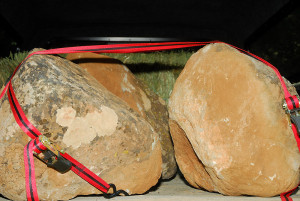
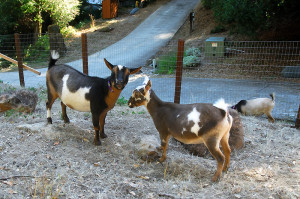
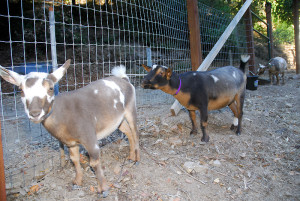
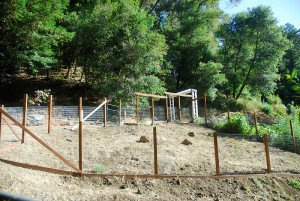
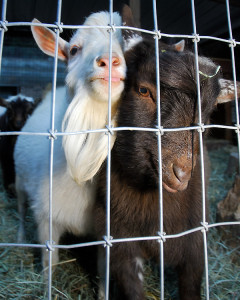







I suppose no project is without its challenges but wow, you had your fair share! The fence looks great and the goats approve, so well done!
Well, it would have helped if I didn’t keep getting distracted through the year 😉 If we’d finished the fence in March, as originally planned, I could have at least avoided being stung. Mr. CV was stung too, more than once, trying to get this finished, but it does feel good to get it done!
Wow! You have been busy, and I’m not kidding! When do you ever take a vacation, or do you know the meaning of that word? I have nothing but admiration for you, and I am always fascinated by your tales. Your photos help to make it all real. I especially like your last photo. Those guys are very charming, and they know it!
I am so sorry about the bee stings. You reminded me of the time when my youngest child stepped into a yellow jacket nest. He had on long, but relatively loose pants, and the bees flew up his pants legs, stinging him multiple times, all the way up to the waist. That is how I found out that yellow jackets build their nests in the ground.
I was a little nervous turning the goats out yesterday, but fortunately the yellow jackets didn’t seem to notice them at all. There’s now a double run of fence between the goats, and where the nest is (between the old deer fence, and the new goat fence), so hopefully that helps.
We once found a yellow jacket nest along a road cut here. We drove the tractor past, and the vibration from the tractor set them off. It was like a stream of yellow and black bullets shooting out of the ground. Fortunately, that time, we managed not to get stung…although we made up for it with this nest. I know they’re good pollinators, I just wish they weren’t so vicious!
Although my projects are much smaller in scope, I’m glad I’m not the only one who has them stretching out over 6 months or more. 🙂
Sorry to hear about the YJ nest. I had my first encounter with them this year, and although I only received 3 stings before I got into the house (much less distance to travel) I know how they feel — can’t imagine 10 or more!
BTW, are all of the female goats pregnant right now?
No, the girls aren’t pregnant yet. Three of them were in heat this weekend, but we’re holding off breeding until their next cycle. Goats are pregnant for 5 months, and we don’t really want kids on the ground before March, as during a normal winter here, it can be unbelievably wet through February. Soon though! We expect to be doing ultrasounds in December, so we’ll know more then 🙂
I love a fence project and although a deer fence for a garden wouldn’t need this type of link fencing, it’s a good model for one around the garden, especially with an arbor gate.
The yellowjackets sound downright evil, I hope you can get rid of them where you walk and work. One sting sent me to the hospital once. I saw an entry hole for a nest down the slope of our place and it had been ravaged by an animal, with the combs all scattered about. We can’t eat outside at all because of them in some seasons.
The word ‘kids’ has a whole new meaning now and the personalities of all the goats are delightful and easier to remember as time goes on. How fun to let them into their new enclosure!
The first year we moved in we woke up one morning and found a huge hole in the ground in the back yard, with comb strewn everywhere. My assumption at the time was that a skunk had dug up a large yellow jacket nest. As much as I’ve vilified the skunks for breaking into the turkey pens, and stealing eggs occasionally, I do have to give them credit for yellow jacket control. Rather them than me! 😉
Amazing when it all comes together Clare…sorry you were stung so badly….